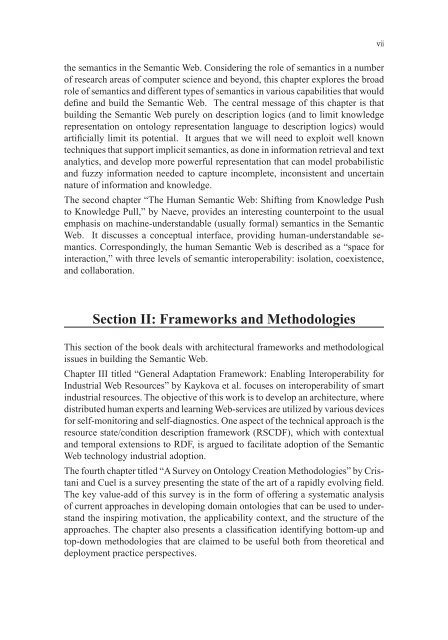Semantic Web-Based Information Systems: State-of-the-Art ...
Semantic Web-Based Information Systems: State-of-the-Art ...
Semantic Web-Based Information Systems: State-of-the-Art ...
You also want an ePaper? Increase the reach of your titles
YUMPU automatically turns print PDFs into web optimized ePapers that Google loves.
<strong>the</strong> semantics in <strong>the</strong> <strong>Semantic</strong> <strong>Web</strong>. Considering <strong>the</strong> role <strong>of</strong> semantics in a number<br />
<strong>of</strong> research areas <strong>of</strong> computer science and beyond, this chapter explores <strong>the</strong> broad<br />
role <strong>of</strong> semantics and different types <strong>of</strong> semantics in various capabilities that would<br />
define and build <strong>the</strong> <strong>Semantic</strong> <strong>Web</strong>. The central message <strong>of</strong> this chapter is that<br />
building <strong>the</strong> <strong>Semantic</strong> <strong>Web</strong> purely on description logics (and to limit knowledge<br />
representation on ontology representation language to description logics) would<br />
artificially limit its potential. It argues that we will need to exploit well known<br />
techniques that support implicit semantics, as done in information retrieval and text<br />
analytics, and develop more powerful representation that can model probabilistic<br />
and fuzzy information needed to capture incomplete, inconsistent and uncertain<br />
nature <strong>of</strong> information and knowledge.<br />
The second chapter “The Human <strong>Semantic</strong> <strong>Web</strong>: Shifting from Knowledge Push<br />
to Knowledge Pull,” by Naeve, provides an interesting counterpoint to <strong>the</strong> usual<br />
emphasis on machine-understandable (usually formal) semantics in <strong>the</strong> <strong>Semantic</strong><br />
<strong>Web</strong>. It discusses a conceptual interface, providing human-understandable semantics.<br />
Correspondingly, <strong>the</strong> human <strong>Semantic</strong> <strong>Web</strong> is described as a “space for<br />
interaction,” with three levels <strong>of</strong> semantic interoperability: isolation, coexistence,<br />
and collaboration.<br />
Section.II:.Frameworks.and.Methodologies<br />
This section <strong>of</strong> <strong>the</strong> book deals with architectural frameworks and methodological<br />
issues in building <strong>the</strong> <strong>Semantic</strong> <strong>Web</strong>.<br />
Chapter III titled “General Adaptation Framework: Enabling Interoperability for<br />
Industrial <strong>Web</strong> Resources” by Kaykova et al. focuses on interoperability <strong>of</strong> smart<br />
industrial resources. The objective <strong>of</strong> this work is to develop an architecture, where<br />
distributed human experts and learning <strong>Web</strong>-services are utilized by various devices<br />
for self-monitoring and self-diagnostics. One aspect <strong>of</strong> <strong>the</strong> technical approach is <strong>the</strong><br />
resource state/condition description framework (RSCDF), which with contextual<br />
and temporal extensions to RDF, is argued to facilitate adoption <strong>of</strong> <strong>the</strong> <strong>Semantic</strong><br />
<strong>Web</strong> technology industrial adoption.<br />
The fourth chapter titled “A Survey on Ontology Creation Methodologies” by Cristani<br />
and Cuel is a survey presenting <strong>the</strong> state <strong>of</strong> <strong>the</strong> art <strong>of</strong> a rapidly evolving field.<br />
The key value-add <strong>of</strong> this survey is in <strong>the</strong> form <strong>of</strong> <strong>of</strong>fering a systematic analysis<br />
<strong>of</strong> current approaches in developing domain ontologies that can be used to understand<br />
<strong>the</strong> inspiring motivation, <strong>the</strong> applicability context, and <strong>the</strong> structure <strong>of</strong> <strong>the</strong><br />
approaches. The chapter also presents a classification identifying bottom-up and<br />
top-down methodologies that are claimed to be useful both from <strong>the</strong>oretical and<br />
deployment practice perspectives.<br />
v


